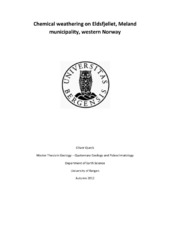Chemical weathering on Eldsfjellet, Meland municipality, western Norway
Master thesis
Permanent lenke
https://hdl.handle.net/1956/6544Utgivelsesdato
2012-11-27Metadata
Vis full innførselSamlinger
- Department of Earth Science [1034]
Sammendrag
The Subject of this master thesis was to define the chemical weathering processes, create a weathering chain from sink to source and to evaluate the degree of weathering on Eldsfjellet, Meland municipality in western Norway. Rock, water and sediment samples were collected in the field area using a corer for hard rock and sediment samples, water samples were bottled in laboratory flasks and afterwards cleaned with a filter to remove colloids and other particles. Multiple analyses such as XRF, XRD, ICP-MS, ICP-OES and microscopy were carried out. The major element, trace element and rare earth element composition of the various samples were acquired. The comparison between trace elements from water and rock samples showed a good agreement which leads to the presumption that water is the major weathering and transport agent in the field area. Because of the low temperature range between summer and winter in the field area, mechanical weathering is assumed to be a less important weathering factor for most of the year. Derived sediment samples from organic rich top layers in the local catchment lake were analysed using XRD. Clay minerals were found which could be directly linked to the local bedrock, therefore it was possible to create a weathering chain. First the bed rock is slowly dissolved due to the permanent supply with fresh water. Secondly, because of the reaction between water and bedrock, clay minerals get produced which then will be, together with other particles, transported to the local catchment lake and finally deposited in the lake sediments. To determine the degree of weathering, different chemical indexes of weathering have been used, all of which show a slight level of weathering. The Elsdfjellet data were compared with data on similar rock types from India, which shows that climatic difference (higher temperature, more precipitation) and a longer transport distance favour chemical weathering in India. To define weathering rates, a formula was used which includes a gain-loss factor calculated from the weight % concentration of different major elements in bedrock and sediment samples. The calculation also displays a low loss of fresh rock material.
